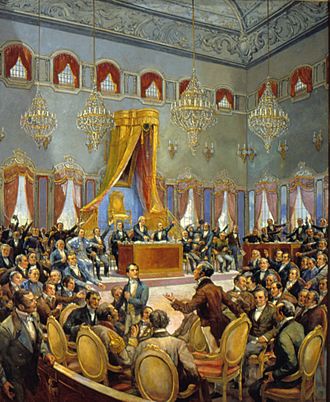Liberal Revolution of 1820 facts for kids
| Part of the Revolutions of 1820 | |

The General and Extraordinary Cortes of the Portuguese Nation that approved the first Portuguese Constitution
|
|
| Date | 24 August 1820 |
|---|---|
| Location | Portugal |
| Participants | Portuguese society |
| Outcome |
|
The Liberal Revolution of 1820 (Portuguese: Revolução Liberal) was a major change in Portugal's government that started in 1820. It began with a military uprising in the city of Porto, in northern Portugal. This uprising quickly and peacefully spread across the country.
The Revolution led to the Portuguese royal family returning to Portugal in 1821. They had been living in Brazil since they fled there during the Peninsular War. This event also started a new period where Portugal adopted a constitution. The 1822 Constitution was approved and put into action. The ideas of this movement, which were about freedom and rights, greatly influenced Portugal's society and government in the 1800s.
Contents
Why the Revolution Happened
From 1807 to 1811, French armies led by Napoleon invaded Portugal three times. Because of this, the Portuguese royal family moved to their colony, Brazil. They stayed there until 1821. From Brazil, King João VI ruled his large empire for thirteen years.
After the French forces were defeated in 1814, Portugal faced many problems. People wanted more control over their own country. This led to demands for the King to return home from Brazil.
Even though Portugal helped defeat the French, the country felt like it was controlled by Brazil or Britain. Portuguese army officers did not like that the British controlled their military. Also, a new rule in 1808, the Decree of the Opening of Ports to Friendly Nations, changed how Portugal traded with its colonies. This rule, along with the Treaties of 1810 in 1810, gave special treatment to British goods entering Portugal. This hurt businesses in cities like Porto and Lisbon, causing a big economic crisis. Porto, a city with strong business owners and a history of supporting freedom, was where the Liberal Revolution began.
Secret Groups and Protests
After Napoleon's final defeat in 1815, a secret group called the Supreme Regenerative Council of Portugal and the Algarve was formed in Lisbon. It was made up of army officers and Freemasons. Their leader was General Gomes Freire de Andrade. Their goal was to end British control and make Portugal independent. This group tried to bring ideas of freedom to Portugal, but they did not succeed at first.
In 1817, some members told the authorities about the group. Many people were arrested, including Freire de Andrade. He was accused of planning against King John VI. At the time, Portugal was ruled by a group called the Regency, which was overseen by the British military leader, William Carr Beresford.
In October 1817, the Regency found twelve of the accused guilty of treason. They were sentenced to death by hanging. Beresford wanted to wait for the King's approval, but the Regency ordered their immediate execution. This happened on October 18. Freire de Andrade was executed on the same day. These executions caused many protests against Beresford and the Regency. They also made people in Portugal dislike the British even more.
A few years later, Beresford went to Brazil to ask the King for more power to stop these secret groups. He was granted this power. But while he was away, the Revolution of Porto started in 1820. When he returned from Brazil, he was not allowed to land in Lisbon.
The Revolution Begins
Inspired by a similar revolution in Spain on January 1, 1820, a liberal revolution began in Porto. It quickly spread to other Portuguese cities and towns without much fighting. The revolution ended with an uprising in Lisbon.
The revolutionaries demanded that the royal family return to Portugal right away. They wanted to "restore the dignity" of the home country. The Liberal Revolution of 1820 not only forced the King to return but also demanded that Portugal become a constitutional monarchy. This meant the King would rule with a constitution that limited his power.
The revolutionaries also wanted to bring back Portugal's special trading rights with Brazil. They wanted Brazil to become a colony again, instead of being a kingdom equal to Portugal. The revolutionaries then organized elections for a special assembly to decide on the future government. The people elected were mostly professionals like lawyers and professors, not the merchants who had started the revolution. These professionals then took the lead. The constitution they approved in 1822 was very similar to the Spanish Constitution of 1812.
What Happened Next
After King John VI returned to Portugal in 1821, his oldest son, Pedro, became the ruler of the Kingdom of Brazil. After several political events and disagreements, Brazil declared its independence from Portugal on September 7, 1822. On October 12, 1822, Pedro was named the first Emperor of Brazil. He was crowned on December 1, 1822. Portugal officially recognized Brazil's independence in 1825.
In 1823, the first revolt against the new constitutional government happened. It was led by Prince Miguel and Brigadier João Carlos Saldanha. They managed to close the parliament and convince King João VI to bring Beresford back as an advisor. In 1826, King João VI died without a clear heir, which caused more problems for the country. When Miguel took the throne, he led another revolt against the constitutional government. This started six years of civil wars between him and his brother, Pedro IV of Portugal, who led the group that supported the constitution.
See also
- History of Portugal (1777–1834)
- Liberalism in Portugal
- Remexido


